If a Drop of Black Paint Is Added to White Paint Can It Ever Be White Again
Colour can exist a complex and overwhelming subject, so in this article we hope to shed some light on the subject field of neutralizing color, or toning it down without changing the color itself or its "color identity". We will bear upon upon methods using White, Gray and Black, Complements, and how the Virtual Paint MXR can function as a helpful tool. Yous can skip ahead to any section that is of particular interest or follow forth with a petty scientific discipline on color mixing!
Subtractive Color Mixing
We all have experiences where in an effort to tone downwards a color nosotros ended upwardly completely changing that color or producing varying shades of brown. Before we become into some advice on how to approach this, it might be helpful to talk about the paint as a physical material first and what happens when we mix colour.
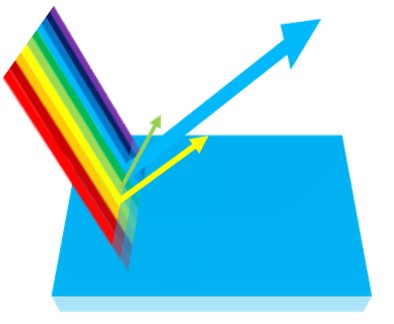
As a concrete, pigmented material, pigment volition reflect wavelengths of lite that correspond to the visual expression of its color and absorb to a greater or lesser degree the remaining wavelengths. The more colors nosotros mix together, the more light is absorbed, producing darker, duller mixtures. This is why mixing pigment is commonly referred to equally "subtractive color mixing" equally in we are subtracting wavelengths of light. Even white, that might seem like an exception, is darkened by anything it is mixed with.
Below is an example of subtractive color mixing where 2 complementary colors become darker and duller the more than they are mixed together. It is also worth noting here that small-scale additions of a complementary colour can serve to tone down a color without dramatically changing its identity. We will become into this in more than depth below.
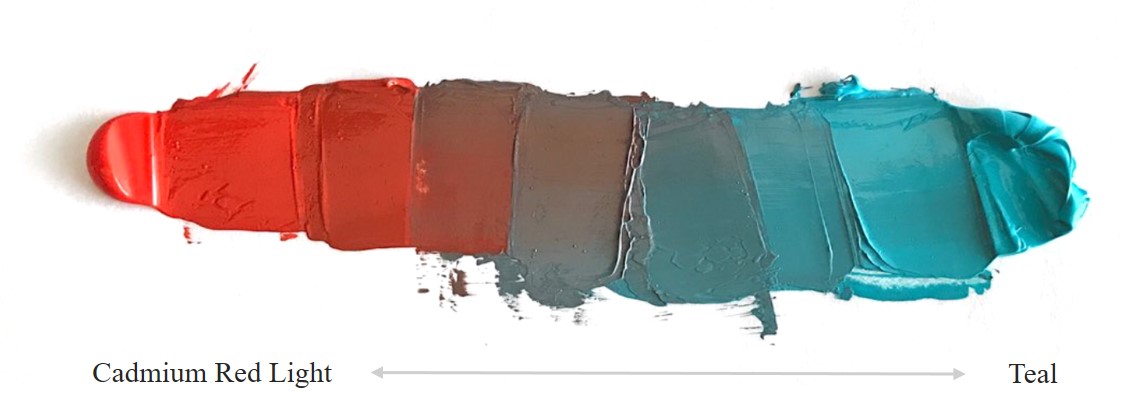
Masstone and Undertone
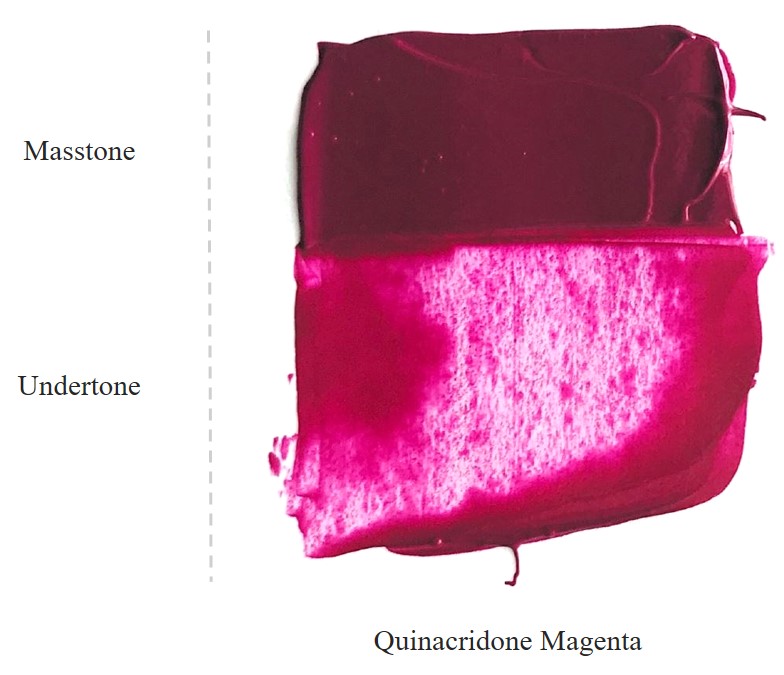
Another affair to exist aware of when mixing color, especially when trying to neutralize colour, is identifying a color'south Masstone and Undertone. The Masstone is visible when paint is applied more than thickly or when looking inside of a jar for instance. The Undertone is most visible when a colour is spread thinly over a surface or mixed with a lot of medium. In this example of Quinacridone Magenta, the Masstone looks much different from the luminous Undertone. The Undertone gives usa a sense of what the bias of this color is. Is it warm or cool, more yellow or blue? With Quinacridone Magenta, knowing it has a cool bias leaning more towards blue will exist important when finding its complement or a color reverse it on the colour wheel.
For more information on color bias and its effect on color mixing, delight refer to our Just Paint Commodity: Defining Warm and Cool Colors: It's All Relative
Methods of Neutralizing Color
Keeping all of this in mind, there are a few ways color can be toned downwardly while mixing without dramatically changing a color'due south identity. The simplest of these being additions of white, greyness and blackness. Other methods such as mixing together complements are a petty more complex, but as effective equally we will illustrate below.
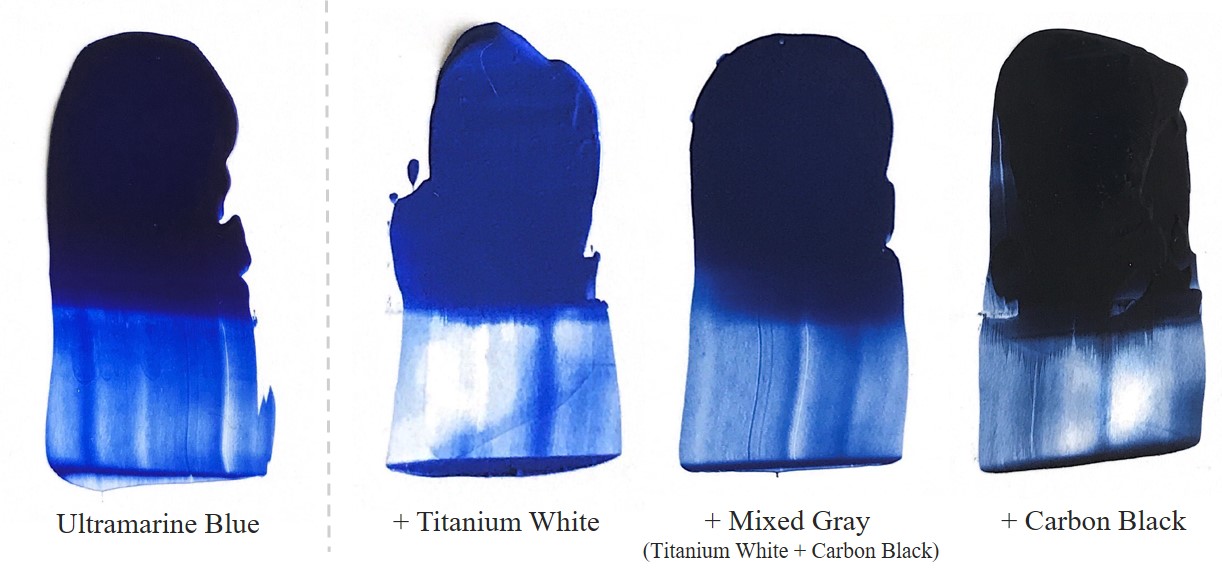
White
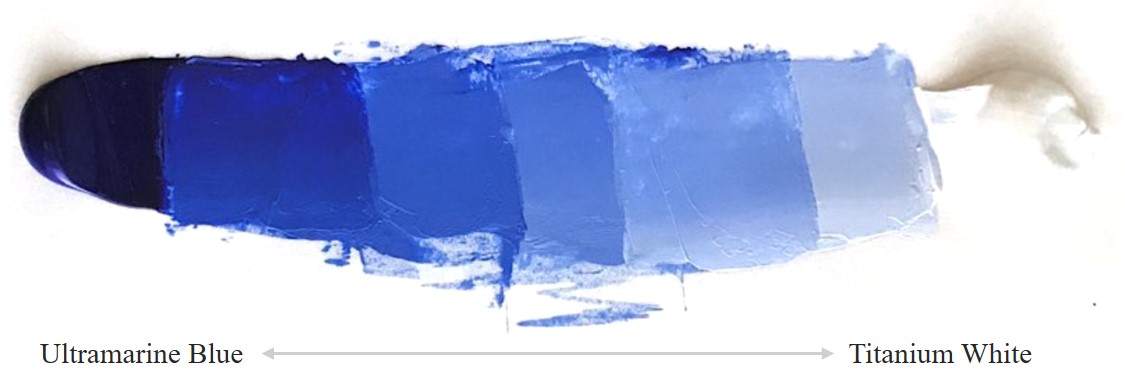
Mixing Titanium White into a colour is an effective method of reducing its saturation, only this volition also accept an effect on the value (lightness or darkness of a color) and its opacity (how opaque or transparent it is). With colors that have a darker masstone like Ultramarine Blue, the addition of white can actually tease out the colour more than, making its Masstone look brighter. As more white is added, it becomes more than pastel and less saturated. Zinc White with its weaker tinting strength can as well be a bang-up white for subtly toning down a color.
Gray
Y'all tin also neutralize a colour by adding greyness. The easiest way would exist to employ one of our Neutral Gray colors that are available within our Heavy Trunk, Open or High Catamenia Acrylic product lines, but y'all can easily mix a gray using white and black if you already take these in your studio. Mixing together two complements to get a gray is possible as well. We will go over this in more particular below. If the gray is the same value as the colour, information technology can be a very effective manner of toning downwards a color with even less change. For more information on our Neutral Grays, please refer to these links below:
Munsell Notations for GOLDEN and Williamsburg Paints
Munsell Annotation Listing
Black
Similar to white, larger additions of black tin take an affect on a colour's opacity and greatly darken its value, but it too can tone down a color. Keep in mind that "black" is a relative term in color mixing, different blacks will be fabricated from different pigments, each with slightly different qualities and biases. For example, Carbon Black, is a cool blackness with a very strong tinting forcefulness, and then frequently a dab volition do! Since Ultramarine Blue is an inherently dark color to brainstorm with, we have included another instance using Cadmium Red Lite.
Complements
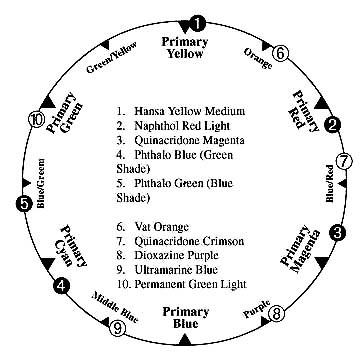
A complementary relationship between colors means that they are on opposite sides of the colour cycle. When truthful complements are mixed together, they can neutralize or cancel each other out, producing a grayness or black. This becomes a flake more than complicated though, considering nosotros are dealing with colors made from pigments that each have unique characteristics and color biases. They do not e'er fall neatly into place on a color cycle equally we can meet on the illustration to the left. Considering of this, finding exact complements can be somewhat challenging. While a expert color bicycle is a keen place to start for finding complements, our online Virtual Paint MXR can be a lifesaver in finding these pairings and working out the mixing ratios to get yous the colors y'all are afterward. More data on this below.

That being said, when possible, direct complements are an incredibly constructive way to tone downwardly color without changing the color's identity. For this example we chose Fluid Permanent Green Light and Quinacridone Red. When mixed together in equal parts they produce an achromatic gray, or a colorless grey approaching black. This ways their color biases abolish each other out, which is an indication that they are proficient complements. When we have just a little of the Quinacridone Red and add it to the Permanent Green, with a footling Titanium White to lighten the color back up (remember, colors will darken with subtractive color mixing), you can encounter that nosotros effectively toned down the Permanent Dark-green with minimal change to its color identity.
Depending on the tinting strengths between a set of complementary colors, the amount of paint needed to tone down a color will vary and may require some experimentation on the palette. Here are a couple more than complementary and near complement scales for some ideas!

Virtual Paint MXR
While digital colour mixing works through an "Additive" process, relying on colored lights rather than material color like paint, our MXR software is designed to simulate "Subtractive" color mixing. Because of this, it may not be possible to achieve the saturation of some colors chosen from a digital source using paint, a physical cloth, just the MXR software does a nice job of getting yous as shut as possible to these colors using GOLDEN Acrylics. The important thing to annotation with this software is that each color is populated with unique data from our lab and colors mixed using the MXR should perform similarly to GOLDEN Acrylics when mixed on a palette.
By choosing a color from ane of the available palettes, (Heavy Body, Fluid, OPEN) we tin seek out its complement from colors nosotros may have available in our studios or more broadly to what is bachelor from a GOLDEN paint line. For example, we had a tube of Teal laying around and without physically mixing it with each color we had, nosotros did a quick glance at a colour bicycle and sought out colors that were between orange and yellowish on the MXR. After a few experiments, we constitute that Pyrrole Orange made an splendid achromatic grey. Nosotros and so tested this further by doing but a small add-on of Pyrrole Orange and we were able to nicely tone down the teal without changing its color. We take re-included our beginning painted example again to evidence just how well this software works!


If y'all haven't used the MXR software before, here is a link to this software again and a short video walk-through of its features:
Virtual Paint MXR
Virtual Paint MXR Tutorial
Nosotros hope this data was helpful. Colour mixing can seem vast, just working on a few key things at a time gives you a lot of control when y'all go to painting! If yous accept any questions or comments most this article or any other paint related topic, please feel free to contact our Materials Application Department at help@goldenpaints.com or by calling 800-959-6543.
lavalleythersellse.blogspot.com
Source: https://justpaint.org/neutralizing-color/


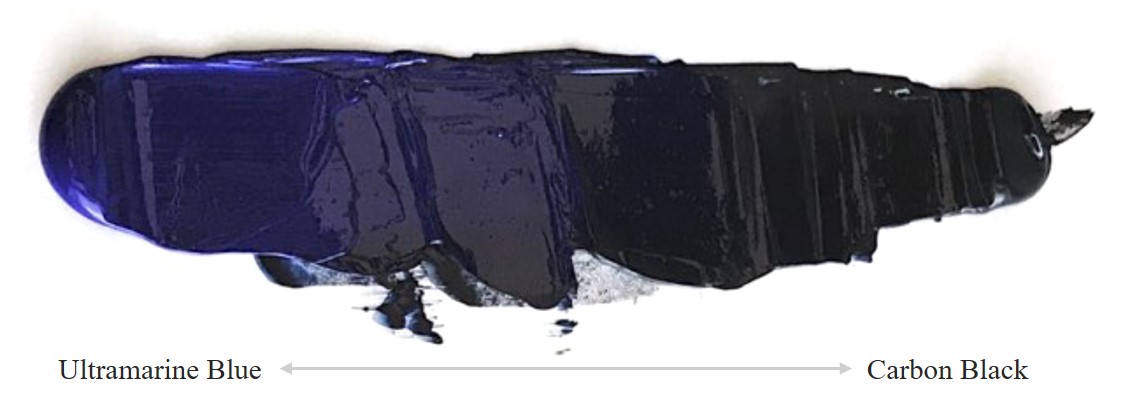
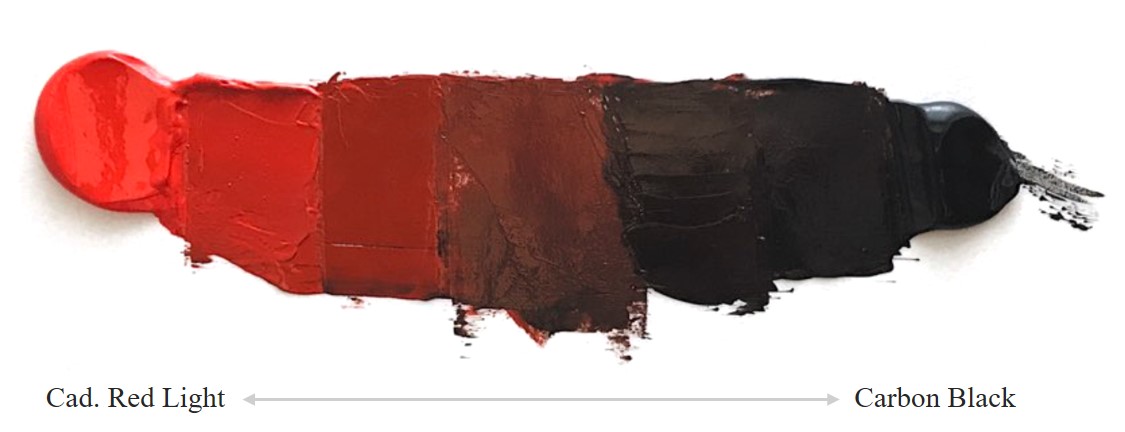
Post a Comment for "If a Drop of Black Paint Is Added to White Paint Can It Ever Be White Again"